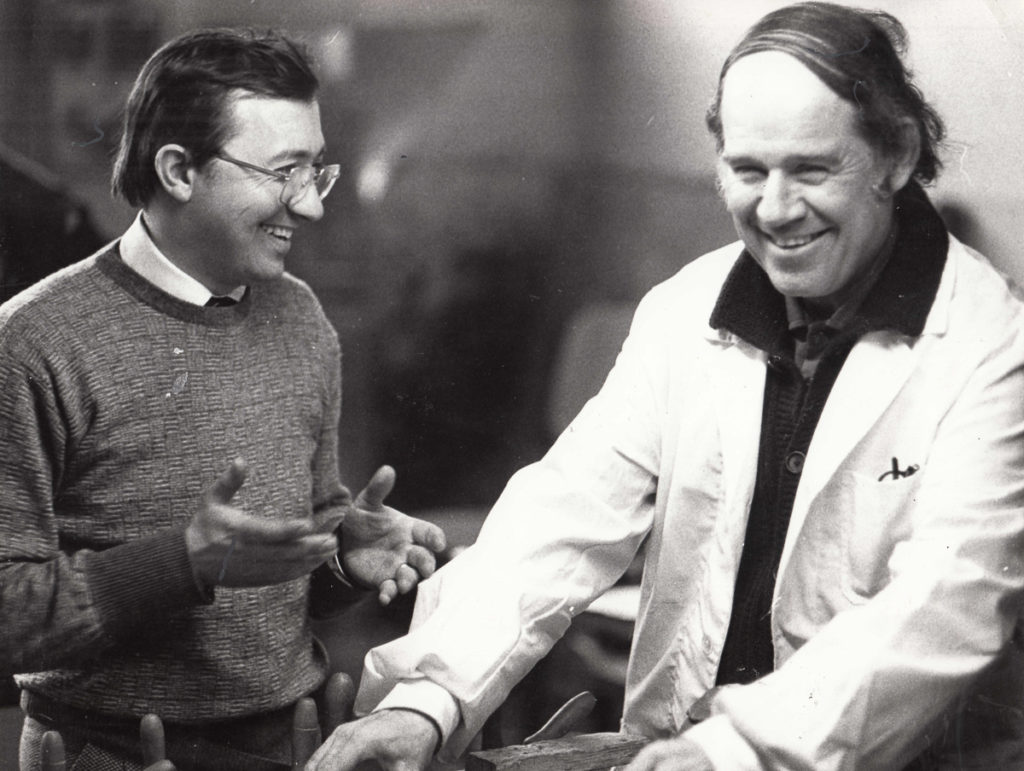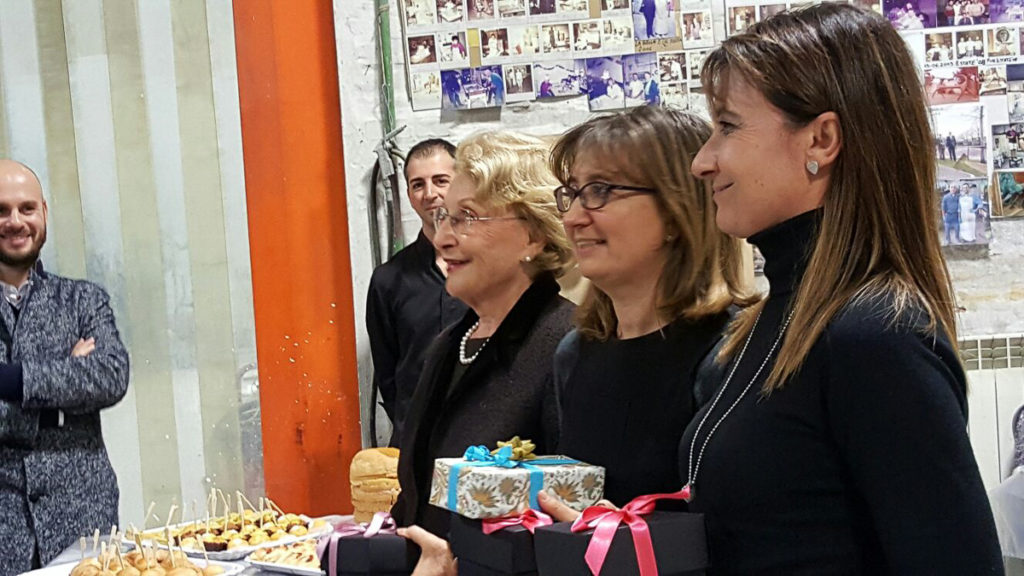In the mid Sixties Gianpaolo Venturi decided to open his own artistic foundry. He was son of the industrial foundryman Paolo Venturi well-known in Bologna. Expert in the art of casting and very interested in innovation in its field, Gianpaolo Venturi started to take care of the most up-to-date technique of those years: the technique of casting in lost wax in refractory ceramic material.It came from military research and was tested in USA to reach high precision steel casting. He got in touch with an American testing engineer, Marshall, who was living in France, and together with him Venturi began experiments to set up artistic casting of bronze.The above-mentioned process was patented and named ‘Plycast Venturi System’.
 With few collaborators and poor equipments Gianpaolo Venturi started to produce high quality bronze casting through techniques unknown in Italy. The first step was taken, but it was hard to find sculptors available to trust Venturi and carry on his research. He was an untiring worker a deep-rooted human dignity which allowed him to involve sculptors such as: Carlo Santachiara, Roberto Tirelli, Gian Carlo Marini, Valeriano Trubbiani, Nello Finotti and Renzo Magonari. They created ‘Multiscultura’, a collection of multiples in 55 good-quality exemplars which witnesses a particular casting quality. The first exhibition of ‘Multiscultura’ took place in 1971 in Vignola (MO). In 1972 Ventrui Arte took part in the International Art exhibition in Basel. Through international exhibitions and private galleries Gianpaolo Venturi succeeded in displaying his skillfulness to the artistic milieu. In that period artists and art editors were seeking experts able to grant the best quality output of bronze multiples. Therefore Gianpaolo were seeking experts able to grant the best quality output of bronze multiples.
With few collaborators and poor equipments Gianpaolo Venturi started to produce high quality bronze casting through techniques unknown in Italy. The first step was taken, but it was hard to find sculptors available to trust Venturi and carry on his research. He was an untiring worker a deep-rooted human dignity which allowed him to involve sculptors such as: Carlo Santachiara, Roberto Tirelli, Gian Carlo Marini, Valeriano Trubbiani, Nello Finotti and Renzo Magonari. They created ‘Multiscultura’, a collection of multiples in 55 good-quality exemplars which witnesses a particular casting quality. The first exhibition of ‘Multiscultura’ took place in 1971 in Vignola (MO). In 1972 Ventrui Arte took part in the International Art exhibition in Basel. Through international exhibitions and private galleries Gianpaolo Venturi succeeded in displaying his skillfulness to the artistic milieu. In that period artists and art editors were seeking experts able to grant the best quality output of bronze multiples. Therefore Gianpaolo were seeking experts able to grant the best quality output of bronze multiples.
 Therefore Gianpaolo Venturi’s proposal fulfilled ancient needs of artistic world. Artists such as Salvador Dalì, Fritz Wotruba, Miguel Berrocal and Paul trusted Ventur Arte and established a mutually profitable relationship. They started exporting bronzes marked ‘Venturi Foundry’ all over the world. In the meanwhile, art editors such as Volker Huber (Germany), Euro Art ( Wien), Ernst Hilger (Wien), Art Curial (Paris) committed their output to Venturi Foundry which finished Seventies improving his organization and deserving world-wide fame. In 1979 at ‘Palazzo delle Vecchie Prigioni’ in Venice, Venturi Foundry arranged a didactic-artistic exhibition of works with explanation of advanced process they used. In the same year, because of an unexpected disease, Gianpaolo Venturi died leaving a gap in the artistic milieu. His wife Gabriella, who had always been working together with him, decided to manage foundry by herself, helped by her sister Tiziana and by a number of employees. In such way she overcame the most difficult moment, the foundry and she herself were crossing. Through this heavy responsibility Gabriella Venturi proved her skillfulness improving more and more organization and output of the foundry. Artistic world changes day by day, requests and trends of market change in the same way. Therefore, after diffusion of sculpture edition and multiples, it was necessary to increase foundry’s productiveness.
Therefore Gianpaolo Venturi’s proposal fulfilled ancient needs of artistic world. Artists such as Salvador Dalì, Fritz Wotruba, Miguel Berrocal and Paul trusted Ventur Arte and established a mutually profitable relationship. They started exporting bronzes marked ‘Venturi Foundry’ all over the world. In the meanwhile, art editors such as Volker Huber (Germany), Euro Art ( Wien), Ernst Hilger (Wien), Art Curial (Paris) committed their output to Venturi Foundry which finished Seventies improving his organization and deserving world-wide fame. In 1979 at ‘Palazzo delle Vecchie Prigioni’ in Venice, Venturi Foundry arranged a didactic-artistic exhibition of works with explanation of advanced process they used. In the same year, because of an unexpected disease, Gianpaolo Venturi died leaving a gap in the artistic milieu. His wife Gabriella, who had always been working together with him, decided to manage foundry by herself, helped by her sister Tiziana and by a number of employees. In such way she overcame the most difficult moment, the foundry and she herself were crossing. Through this heavy responsibility Gabriella Venturi proved her skillfulness improving more and more organization and output of the foundry. Artistic world changes day by day, requests and trends of market change in the same way. Therefore, after diffusion of sculpture edition and multiples, it was necessary to increase foundry’s productiveness.
 In this context, production of large-size works with a new process was carried out with remarkable results. In 1987 took origin a collection of furniture complements named ‘Le Forme del Fuoco’ (Shape of Fire), realized for the greater part by sculptor Gilbert Kruft. This collection, promoted and distributed by Venturi Arte, is still an important part of foundry’s output. In the early Nineties, after graduation, Giovanna and Roberta (Gianpaolo and Gabriella’s daughter) acquired enthusiastically the management of the foundry with differents tasks. In the world of casting it is really uncommon the presence of women in management.
In this context, production of large-size works with a new process was carried out with remarkable results. In 1987 took origin a collection of furniture complements named ‘Le Forme del Fuoco’ (Shape of Fire), realized for the greater part by sculptor Gilbert Kruft. This collection, promoted and distributed by Venturi Arte, is still an important part of foundry’s output. In the early Nineties, after graduation, Giovanna and Roberta (Gianpaolo and Gabriella’s daughter) acquired enthusiastically the management of the foundry with differents tasks. In the world of casting it is really uncommon the presence of women in management.
